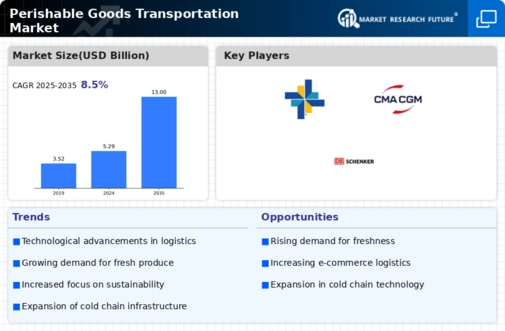Market Share
Perishable Goods Transportation Market Share Analysis
In the dynamic landscape of the Perishable Goods Transportation Market, companies strategically deploy various market share positioning strategies to establish a robust presence and gain a competitive edge. One fundamental strategy involves a comprehensive focus on logistics efficiency and cold chain management. Given the sensitive nature of perishable goods, transportation providers in this market emphasize state-of-the-art refrigeration and temperature control systems, ensuring that products like fresh produce, pharmaceuticals, and frozen foods are transported under optimal conditions. By prioritizing the reliability and precision of their transportation services, companies aim to position themselves as leaders in the market, meeting the stringent requirements of industries that rely on the safe and timely delivery of perishable goods.
Cost leadership is another pivotal strategy embraced by companies in the Perishable Goods Transportation Market. This approach revolves around optimizing transportation routes, implementing fuel-efficient technologies, and streamlining operations to minimize costs. Becoming a cost-effective provider enables companies to offer competitive pricing for their perishable goods transportation services, attracting a broader customer base. Cost-effective solutions not only appeal to price-conscious shippers but also provide companies with a strategic advantage against pricing pressures and market fluctuations, ensuring sustained profitability and market resilience.
Market segmentation plays a crucial role in the positioning strategies of perishable goods transportation providers. Recognizing the diverse needs of different industries, companies tailor their services to address specific market segments. This may involve offering specialized transportation solutions for pharmaceuticals with stringent temperature requirements, or time-sensitive delivery options for fresh produce. Effective segmentation enables companies to optimize their market share within specialized niches, providing transportation services that precisely meet the needs of various industries and perishable goods categories.
Strategic collaborations and partnerships are instrumental in enhancing market share positioning within the Perishable Goods Transportation Market. Companies often form alliances with food producers, pharmaceutical manufacturers, and retailers to strengthen their supply chain, expand market reach, and facilitate innovation. Collaborations can lead to joint logistics planning, shared resources, and the development of application-specific transportation solutions. Partnering with key stakeholders allows companies to leverage collective strengths, share expertise, and collectively address the complexities of the perishable goods transportation industry more effectively, contributing to increased market share.
Sustainability is emerging as a significant factor influencing market share positioning strategies in the Perishable Goods Transportation Market. With an increasing emphasis on environmentally friendly practices, companies are exploring green transportation solutions, optimizing fuel efficiency, and investing in eco-friendly technologies. Transportation providers positioning themselves as environmentally responsible entities can gain favor among customers who prioritize sustainable and responsible logistics, contributing to the overall sustainability of the industry.
Moreover, a robust digital presence is crucial in today's technologically driven business environment. Perishable goods transportation companies leverage digital platforms, real-time tracking systems, and advanced analytics to enhance visibility, communication, and efficiency. An effective online presence enables companies to provide transparent and real-time information to customers, optimize route planning, and facilitate seamless communication throughout the transportation process, enhancing brand visibility and trust in the competitive perishable goods transportation market.






Leave a Comment